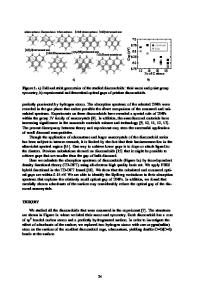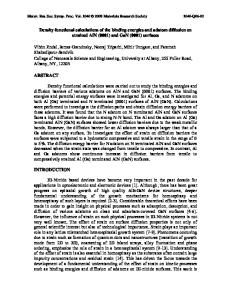Recent trends on density functional theory–assisted calculations of structures and properties of metal–organic framework
- PDF / 833,539 Bytes
- 15 Pages / 584.957 x 782.986 pts Page_size
- 20 Downloads / 479 Views
Recent trends on density functional theory–assisted calculations of structures and properties of metal–organic frameworks and metal–organic frameworks-derived nanocarbons Oxana V. Kharissova1, Boris I. Kharisov1,a), Lucy T. González2 1
Universidad Autónoma de Nuevo León, San Nicolás de los Garza, Nuevo Leon 66455, México Tecnologico de Monterrey, Escuela de Ingeniería y Ciencias, Monterrey, Nuevo Leon 64890, Mexico a) Address all correspondence to this author. e-mail: [email protected] 2
Received: 9 March 2020; accepted: 17 April 2020
Metal–organic frameworks (MOFs) possess tuneable properties and a variety of important applications in the areas of catalysis, adsorption, gas storage, and separation, among others. Herein, recent computational studies by density functional theory (DFT) applied for simulations of MOF structure and complex architecture determination, prediction of properties, and computational characterization, including large-scale screening and geometrical properties of hypothetical MOFs, diffusion and adsorption processes in MOFs, are reviewed. DFT calculations have been applied in the MOF area to study chemical stability; mechanical, photophysical, optical, and magnetic properties; photoluminescence; porosity; and semiconductor or metallic character. The prediction of MOF analogs with open-metal sites, studies of chemical bonding and the prediction of energies by quantum mechanics allows reducing experimental efforts in the creation of MOF/polymer membranes, adsorbents for CO2 uptake, separation of C2H2/CH4, C2H2/CO2, and inert gases, radionuclides sequestration, and water adsorption, as well as other promising advances. For the MOF-derived carbons, a lack of profound DFT investigations is currently observed, being mainly restricted to the electrocatalysis area (nitrogen reduction reaction, oxygen evolution reaction, and hydrogen evolution reaction), resulting applications in batteries and other storage devices, CO2 sequestration, and absorbance of organic substances.
Introduction The metal–organic frameworks (MOFs) [1, 2, 3, 4, 5, 6, 7, 8] belong to an exciting category of solid-state porous materials with structures, containing a combination of two components: building units (metal ion or metal O-containing cluster, having the node function) and organic linkers bridge (acting as a connection between nodes), representing porous coordination polymers. Based on these peculiarities, MOFs possess intriguing and tuneable properties (shape, pore size, surface chemistry, and topology) and relative applications in a variety of fields as filtration, chemical sensors, magnets, devices for controlled drug release, and especially in separation methods, heterogeneous catalysis, capacitors, biomedicine, sorption, gas storage, and uptake, and others [9, 10, 11, 12]. MOFs availability for a series of applications of modern physics was
ª Materials Research Society 2020
discussed in a review [13], in particular as optical superstructures, topological insulators, porous metals and superconductors, and quantum
Data Loading...











